U.S. Department of Transportation
Federal Highway Administration
1200 New Jersey Avenue, SE
Washington, DC 20590
202-366-4000
FHWA Resource Center
Office of Innovation Implementation
Adobe PDF Version of the Environmental Quarterly
Volume 2, Issue 2
LETTER FROM THE EDITOR
Dear Environmental Colleague,
As we look back on the 37th celebration of Earth Day on April 22, it is worth noting the progress that has been made within the entire transportation community to enhance the human and natural environment. This commitment to environmental stewardship has improved our communities and provided better transportation decision-making. We are pleased to play a small role in this continuing effort with the publication of another
Environmental Quarterly.
Sincerely, Don Cote
Environment Technical Service Team (TST) Leader &
Editor–in-Chief
Phone: (720) 963-3210
E-mail: Don.Cote@fhwa.dot.gov
INSIDE
• Green Highways Forum Report
• Linking Planning & Environment - Texas Style
• Long Term Studies, Risk, Assessment and Baseline Conditions
• ND manages limited construction time
• Environmental Calendar
Green Highways Forum Report
By Dave Gamble
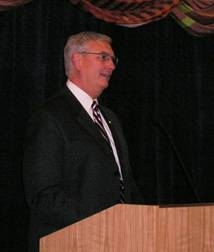
Photo of EPA Administrator Stephen Johnson addressing the Green Highways Forum participants during a keynote speech.
A funny thing happened on the way to the forum … the Green Highways Forum (GHF), that is. A highway construction contractor who recycles old tires into new pavement and a wetlands biologist, concerned with ecosystem enhancement, found out they had more in common with one another than either had ever imagined. OK, maybe that exact exchange did not occur at the forum, but
given the diverse mix of participants it was entirely possible.
The GHF was held in early November 2005 in College Park, Maryland, to showcase the Mid-Atlantic Green Highways Initiative originated by the Environmental Protection Agency (EPA) Region III Philadelphia office. Several hundred participants came from a wide variety of public and private entities representing design, construction, materials, environmental protection and planning, resource management, recycling, and a myriad of other backgrounds. Sponsors included the Federal Highway Administration, Maryland State Highway Administration, American Concrete Pavement Association, American Coal Ash Association, EPA, and other groups.
They all came together to learn more about this initiative, which is described as "a voluntary, collaborative, public/private effort designed to identify & promote streamlining and environmental stewardship in transportation planning, design, construction, and/or operation and maintenance through integrated partnerships, flexibility, rewards, and market-based solutions.
In short, the intent was to promote environmentally friendly highway practices, while sustaining life-cycle functional requirements of transportation infrastructure (safety, structural & service levels). Put more simply, to support a goal of leaving conditions better than before.
This philosophy was the focus of an excellent video titled Better than Before II produced by the New York State DOT. The video describes how NYSDOT has incorporated sound environmental stewardship practices throughout their organizational culture. It was one of many interesting presentations made during the forum that included parallel tracks covering planning and preliminary design, final design and construction, and operations and maintenance.
Other presenters focused on project level success stories as well as broader regional initiatives, ranging from how bog turtles were treated on a
Maryland project to the incorporation of steel furnace slag into highway pavements. So you see, there probably were many sidebars between folks of divergent backgrounds. Do opposites attract? Maybe, but many participants discovered shared interests after all.
For an initiative such as this to succeed, however, it must be based upon more than interesting presentations. Even though a mission statement and guiding principles had been established by the time the forum was held, for example, questions remained among the participants regarding practical applications of the initiative and sustaining it as it expands to be National in scope.
To address these remaining issues and identify other concerns, facilitated breakout sessions were included in the program taking advantage of the divergent backgrounds of the participants. A number of themes emerged from these sessions including building upon existing successful practices of which many were mentioned, including context sensitive solutions, promoting sustainability, stressing economic benefits of green practices, and fostering meaningful partnerships. Foremost for many at the forum was the desire that the initiative remain voluntary and not result in a certification program.
Other notable developments included keynote speaker EPA Administrator Stephen Johnson characterizing the forum as the launching of a movement that can bring transportation and environmental fields together. He likened it to his agency’s brownfields program for the recovery and reuse of industrially contaminated sites, and invoked the term "greentops" (versus blacktops) to describe a likely outcome at the project level. Cindy Burbank, FHWA Associate Administrator for Planning, Environment, and Realty, pledged $500,000 to support the initiative. She also suggested that it could be fashioned after the popular Scenic Byways Program.
So what happens next now that the GHF has concluded? Those features that will lead to a green highway will continue to be identified, with everyone in agreement that excessive obstructions should not be added to the project development process. A Steering Committee has been formed, and the EPA will establish a green highways information clearinghouse. Work groups are also being formed around the following three subject areas: watershed storm water management, ecosystem management, and materials recycling and reuse. And the green highways initiative was the subject of a workshop held at the Transportation Research Board’s annual meeting in Washington D.C. on January 22. Stay tuned, as you will be hearing much more about this initiative in the coming months
For more information on the Green Highways Forum, contact either Denise Rigney or Dominique Lueckenhoff, both from EPA Region III, rigney.denise@epa.gov or lueckenhoff.dominique@epa.gov, respectively.
Green Highway Graphic courtesy of Andy Fekete, RBA Group.
Photograph courtesy of Ed Ambrogio, EPA Region III.
For more information on the New York State DOT environmental initiative.
Proving that a picture can be worth a thousand words, Andy Fekete from the RBA Group offered the following graphic depicting assorted "on-ramps" to a green highway:
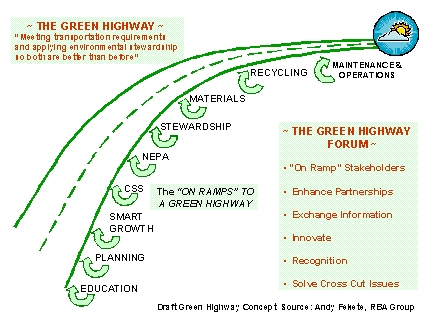
Illustration of highway representing the Green Highways Initiative. Onramps are labeled Education, Planning, Smart Growth, CSS, NEPA, Stewardship, Materials, Recycling, Maintenance Operations. The onramps illustrate how each element contributes to Green Highways. The Green Highway is defined as Meeting the transportation requirements and applying environmental stewardship so both are better than before. A chart details what the Green Highway Forum will address: the Stakeholders, enhancing partnerships, exchanging information, innovating, recognition, solving cross cutting issues.
Andy’s on-ramps all represent existing processes such as education, smart growth, context sensitive solutions, and recycling, so other new ones are not needed to develop a green highway. Instead, a green highway would result from effective collaboration by stakeholders on common goals and principles -- the shared interests mentioned earlier.
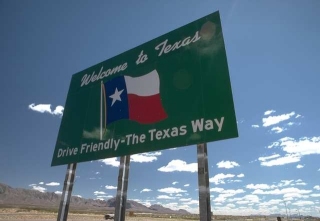
Photo of Texas highway welcome sign saying Welcome to Texas, Drive Friendly – the Texas Way along with an illustration of a Texas flag..
Linking Planning and Environment – Texas Style
In the typical Texas tradition of excellence, the Texas Division Office Planning and Program Development (PPD) Section (Planning/Environment/Right-of-Way functions) took the Agency instruction to improve the linkages between planning and environmental goals in both ISTEA and TEA-21 to heart. The desired result was to truly "consider environmental concerns early in the planning process." Leadership including Mike Leary and his predecessor--PPD Director, Irene Rico, saw that the key to implementing this vision was a more-integrated interdisciplinary approach. After much consultation with Human Resources in Atlanta, the concept was approved for adoption by the Division Administrator December, 2003. PPD staff then began planning how to implement the new position description restructuring. This was accomplished by combining the two functions into one job and reassigning one staff member--on a permanent geographical assignment--oversight of the entire pre-construction process from beginning to end. The desired results were two-fold:
1. By combining positions, PPD staff would be in a better position to understand and integrate Planning and Environment program objectives. This geographical assignment would give the FHWA specialist an expansive knowledge of the area and both the state and local officials involved, as well as an appreciation of the transportation needs and project concepts. At a minimum--this would improve communication. There is only one face representing FHWA within a district. This is important because Texas is such a large state and the TxDOT still has these functions separated.
2. Combining functions would provide a form of job enrichment for PPD staff by giving them: more responsibility, exposure to new subjects, opportunities for flexible work assignments within the Division Office, and enhanced opportunities for future career advancement.
The changes were implemented in stages. For the first 60 days beginning January 2004, responsibilities remained the same. However, all documents (Statewide Transportation Improvement Program [STIP], Unified Planning Work Program [UPWP], etc.) were also passed to the person who would have geographic responsibility in the future for review and comment. Whenever possible, both individuals attended both the planning and environmental meetings. Review and approval of document schedules had to conform to the Division Office’s Stewardship Plan with the State. Workload distribution (by process) varies depending upon an individual’s level of knowledge and experience; i.e. it may currently be 80% planning, 20% environmental. It will be realigned as their expertise grows. This prevents the individual from becoming overwhelmed with the demands of too much new responsibility.
By March of 2004 the reassignment plan for the FHWA Texas Division Office was fully implemented. Individual position descriptions and the FY 2004 Work Program had been rewritten to reflect the changes as part of the PPD Team. Next, briefings of the changes and introduction to new assignees had to be made to the Texas Department of Transportation (TxDOT) Planning, Environment and Public Transportation sections. The Annual Texas Transportation Planning Conference, held in June, provided an opportunity for PPD staff to present the new operations plan and introduce staff to the transportation community at large. In September 2004 an assessment of the implemented changes was made, allowing for necessary realignment of responsibilities.
Major constraints had to be overcome, including getting the new position descriptions approved by Atlanta Human Resources. The FHWA Texas Division Administrator’s approval of the new position descriptions was another critical action, and the in-house staff reluctance to take on additional responsibilities in areas for which they lacked current knowledge and experience had to be overcome. In the future, this transition to new areas of responsibility can be made more gradually as new staff members accrue experience and knowledge.
How is it working? Generally, GREAT! PPD staff members say it is a win-win and that their work experience is much richer. Everyone benefits when an interdisciplinary, integrative approach like this is adopted. It is a great opportunity to get training and offers career flexibility, as well as flexibility within the Division Office depending upon work load. Work is much more interesting and satisfying for PPD staff because they are working with so many different issues, and they can provide better service to their customers. Already PPD staff members have been at Metropolitan Planning Organization public meetings where they could provide valuable expertise as a result of their broader experience. This knowledge of the human and natural environmental laws under National Environmental Policy Act (NEPA) makes the FHWA input to consideration of avoidance and mitigation options much more meaningful at the planning stage. FHWA’s contact with the resource agencies allows for earlier input and more comprehensive and meaningful interagency coordination.
PPD staff are now able to take on early metropolitan/regional/ statewide planning and project development issues in a more comprehensive and systematic way because they are talking to Central Office TxDOT Environment and Planning staff, as well as their District counterparts. This is accomplished through frequent visits, one-on-one meetings and telephone communications.
In order to proceed, cross-training of staff was necessary. It was accomplished through a combination of in-house weekly short training sessions that covered highest priority topics at the metropolitan, statewide and NEPA environmental levels, in addition to NHI/NTI sponsored formal training.
Unanticipated benefits to PPD staff include the increased knowledge and professionalism that has been developed as a result of the cross training. This growth is recognized by their customers. A side benefit for the individual is an increase in promotional potential within the agency. Texas PPD staff now possesses a comprehensive understanding of environmental laws, goals, and regulations, as well as SAFETEA-LU metropolitan and statewide planning laws, goals and requirements.
This comprehensive understanding of multiple processes has resulted in a much richer preliminary planning initiative. Project successes reflecting this advantage include the Katy Freeway in Houston, and the Harbor Bridge DEIS now underway in Corpus Christi. The Harbor Bridge DEIS is scheduled to be completed within just three years by TxDOT Corpus Christi District utilizing the results of a major corridor planning feasibility study prepared by the same consultant working on the DEIS. This project has been cited as an early example of streamlining through negotiated timelines.
Efficiencies come from having the same person review an environmental document from both the planning and environmental perspectives. Of course, there are travel efficiencies--with good trip scheduling and planning -- one trip can cover a MPO Policy Board
meeting as well as a visit with the TxDOT District environment staff. Another advantage is that the FHWA staff person is aware early on of needed Metropolitan Transportation Plan (MTP) and Transportation Improvement Program (TIP) changes and can monitor those actions in a timely manner. Knowledge of necessary and pending planning deadlines including air quality conformity determinations can be critical in order to maintain a $5B a year highway and transit program (with 1100-1200 projects let per year) moving forward within the State of Texas.
By focusing on one or more geographical area, PPD staff will have more opportunities to interact with TxDOT personnel and can therefore develop good working relationships and visibility. The PPD staff still relies on one another for peer advice and assistance based upon their collateral duties and their own areas of expertise, so that in-house support remains focused on meeting the needs of their customers in a timely manner.
When asked how their work flows across the work year, PPD staff said it is pretty balanced and they haven’t experienced much conflict. Major planning milestones are known well in advance and environmental work tends to be steadier.
There have been a few unanticipated issues that have emerged, of course.
• Initial staff reluctance--the heavy burden of a number of collateral duties and associated levels of responsibility can be daunting. Planners have a lot of collateral responsibilities. For example, the Statewide Planning Engineer’s roles and responsibilities include: freight and international border planning, Highway Performance Monitoring System (HPMS) annual reviews, Continuous Process Improvement (CPI) technical reviews, annual highway statistics reports, highway functional classification revisions, adjusted census urbanized area boundary, certified public road mileage reporting, truck size & weight issues, Heavy Vehicle Use Tax (HVUT) reviews, etc. Because of the increased NEPA roles and responsibilities, the learning process took a transition period in order for PPD planners to become fully comfortable in serving dual roles as both NEPA and planning coordinator for their assigned geographic areas.
• Travel budgets have been tight, compounded by all the funding restrictions created by numerous continuing resolutions.
Internal to the Division Office, the realignment has had no negative effects upon the coordination that takes place with the Engineering staff (which has always been very good). By PPD staff handling more functions, the number of coordination points can be fewer.
In Conclusion: The change to combined planning and environmental positions has worked very well for the FHWA Texas Division with just a few small bumps in the road. You may be surprised to hear that Texas has not yet had the benefit of the "Linking Planning with Environment" NTI-NHI course. It is scheduled for late January/early February 2006 for Austin, Texas. So, they were really taking a bold leap into the frontiers of SAFETEA-LU. Texas has been selected as one of the five pilot states to receive NEPA delegation, so there are more changes ahead for PPD staff as they implement new Congressional goals and visions in Texas. In addition, the FHWA Texas Division Office has also been working with the U.S. DOT’s Volpe Center as part of a Planning Collaboration Initiative to improve tracking of SAFETEA-LU planning documents and their due dates via a website portal. Stay tuned for the next chapter of this story!
Contributors: Mitch Batuzich, Kirk Fauver, Becky Lupes and Barbara Maley. Edited by Jose Campos, Intermodal Team Manager and Mike Leary, Director--PPD, Texas Division.
Thanks to the Texas PPD staff for all their input and assistance in producing this article. If you need to talk directly with one of them about aspects of this article, any one of them can assist you.
![]()
Texas Department of Transportation logo.
Long Term Studies, Risk Assessment, and Baseline Conditions
By Kevin Moody
Risk assessment is an important tool that can enhance the transparency of analyses used to support transportation decisions. For example, the baseline information contained in our NEPA and other decision support analyses are by necessity biased. Disclosing the implications of that bias constitutes a risk assessment.
Broadly speaking, impact studies of alternatives for NEPA and other decision support analyses can be said to test a null hypothesis of "no change" against "detectable change." It is important to remember that most human and natural environments are dynamic, which means that we introduce bias into the analysis when we characterize the baseline condition as static, fixed, or as a snapshot in time. The accuracy and precision of predictions about changes imposed by proposed actions is a function of knowledge of the variations in the baseline absent the proposed action.
Variations in the baseline condition, when known, should be reported. The variations are, in essence, null-hypothesis error terms, which should not be confused with sampling error estimates.
When not much is known about the natural variability in the environment under study, it is worth documenting the uncertainty and what the biases it introduces mean to the predictions. In many cases, disclosure can be accomplished by discussing the implications of: (a) finding that impacts would be significant when they would actually be negligible (Type I error); and (b) finding that impacts are insignificant or negligible when they really would be significant (missing the effect; Type II error). In sensitive cases, it may be worthwhile to use statistical techniques to quantitatively estimate the probability of missing a significant effect. Whether qualitative or quantitative, discussing the implications of analytic biases constitutes a risk assessment that will help the decision maker and enhance the transparency of the evaluation.
The value of risk assessments related to baseline bias is particularly high for some transportation proposals, where we may have concerns about potential impacts to water quality, habitat fragmentation, community cohesion, induced growth, and other environmental components. Such components are influenced by a number of cofactors, which are difficult to tease out absent information about trends absent the project.
The lack of information about temporal and spatial variation in the baseline condition may be unavoidable because of time and fund availability on a project by project basis, but from a programmatic perspective, long term studies which provide reliable estimates of baseline variation may be worthwhile investments for transportation agencies and their partners. Regular data points, collected over time and space, can help ensure that the degrees of freedom for the baseline error terms are adequate for robust analyses.
Working with your local subject matter experts to design and initiate long term studies to reduce the risk of Type I and Type II errors in NEPA and other decision support documents will generate next generation benefits to this Nation’s transportation program.
For more information, contact Kevin Moody at (404) 327-7387 or kevin.moody@fhwa.dot.gov .

Earth Day graphic cartoon showing the words Earth Day wrapped around a drawing of planet Earth
North Dakota Department of Transportation graphic

UP NORTH…
WHERE TIME IS OF THE ESSENCE
Transportation professionals from states with very large programs might assume that, comparatively, a rural Midwestern state with a "smaller" program has many less problems in execution and, therefore, probably works with less urgency. The fact is that these smaller-program states deal with some very specific constraints that force them to high levels of efficiency--in this case: time constraints.
North Dakota--being a northern tier and border state with a relatively small program (dollar-wise)--has long and severe winters resulting in a very brief three-to-four month construction season. Timing is critical up there. In order for a road deficiency to be addressed within a single calendar year, the project must be ready to go to bid by late February or early March if construction is to begin immediately when the warm season arrives. If that bid deadline is not met, the improvement must wait an entire year before the construction opportunity will present itself again. Or, a late start means that the project--once construction starts--will lie dormant throughout the winter and require two construction seasons. The motoring public would then have to contend with the inconveniences, delays and dangerous conditions of a dormant construction site throughout the winter season. That is not desirable! This means that planning and project development must move right along.
It also happens that the North Dakota Dept. of Transportation (NDDOT) and FHWA Division take their responsibilities for a comprehensive Public Involvement Program (PIP) very seriously. At the same time, the North Dakota citizenry expects a full opportunity to participate in highway investment decisions. As we all know, a good project PIP takes a lot of time. So the challenge was (is)…how to execute a quality PIP in the most expeditious manner possible so the tight project schedule can be kept. The NDOT Office of Local Governments shoulders this responsibility. Components of North Dakota efficient operation are as follows:
• Time is spent at the beginning of each year educating city and county engineers, as well as local elected officials (positions that turnover frequently), as to the full requirements of the Federal Aid process and advise local officials of timelines. . .
Maintaining an efficient relationship with FHWA (as well as the local engineers and decision makers) is essential. To keep the ambitious schedule mentioned above, time for a lot of formal letter exchanges does not exist--which (as they say) "eats the clock". So most decisions are made through phone transaction, sometimes sever exchanges--until they can come to a mutual agreement. (Note: The Resource Center adds that even those informally-made
• decisions must be documented and incorporated into the project record.) North Dakota is fortunate in that most of their consulting design firms reside within the state, so they, too, are participants in these expeditious telephone transactions.
• In order for this less-formal project development process to work there must be an extremely high level of trust. All parties involved must regard themselves and the others as full partners and committed to the philosophy that "we’re all in this together". Each must be confident that the other parties will not hold back information and that all parties will always keep one another fully informed. It is to be recognized that this level of trust does not occur overnight, but is a long-term building process that must begin with top management of all agencies.
• The Public Involvement (PI) aspect becomes all the more prominent when the proposed project is either very complicated or controversial. The more sensitive a project, then "even more PI is better". North Dakota operates on the same trust building philosophy with the public. Everyone involved is kept fully informed at all times (including the involved public). Project decision making is genuinely a shared process. NDOT’s experience has been that invariably the local citizenry is willing to consider several good alternatives and eventually one of those alternatives will be acceptable to all, even the groups who held differing opinions.
An example of this way of doing business is the controversial Valley City Rainbow Arch Bridge Replacement project. Many might consider the PI effort to have been "overkill". This project involved the participation of a number of very diverse groups of citizens--from the Rotary Club to the Ladies’ Tea Clubs. Preservation, as well as safety issues were on the forefront. With more and more exposure to information and important decision factors, a sense of assurance evolved that "no one is trying to pull one over" on anyone. Opposition began to dissolve and eventually compromises were reached, resulting in the development of a compromise alternative that could be further examined by all the interest groups. Deal breakers were resolved through discourse and compromise, and--in the end--a superb project emerged that was able to meet its bid schedule. The human dimension of this dynamic was that when all parties felt they "were truly heard", they were then able to "move out" of their original position, resolve differences and arrive at a compromise.
NDDOT and the FHWA had to develop the patience necessary to allow this dynamic to happen. Both agencies are genuinely committed to project designs that reflect local input. In the future they fully intend to go beyond the PI requirements to make sure this happens with all such projects. A lot of time, work and concern is invested in this way of doing business, but in the end the process produces good projects and is much more efficient in reaching the common goal of "moving construction". Some would call these strategies Streamlining and/or Context Sensitive Design, but North Dakota just thinks of it as "doing business the smart way".
One of the long-term dividends of this investment is that once a community is involved in such a process, there is a great deal of "residual carry-over" to be captured when addressing future problems and projects.
If you would like to know more about the North Dakota way of doing business, give Dave Kline (Office of Local Governments, NDDOT) a call at (701) 328-4336, or Mark Schrader (North Dakota FHWA Division) at (701) 250-4343, extension 111.
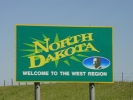
Photo of North Dakota state welcome sign.
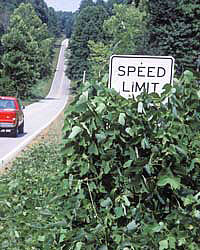
Photo of roadside of two lane road with kudzu covering half of a speed limit sign.

Photo of roadside covered with kudzu with pedestrian crossing sign.
Dandelions or Kudzu???
By Bonnie Harper-Lore
If I had to chose, it would be dandelions. Oh, the question is: which would I rather have growing in my backyard, or along State highways. We know how to control dandelions and they have not impacted parklands or agricultural lands. However, that is not true of kudzu. There is now so much kudzu, southern States cannot afford to get rid of it.
But kudzu only grows in the southern or Mid-Atlantic states! Well, that is what we once thought. But like all invasive plants, kudzu continues to adapt and spread to new territory. It has now crossed a border into Wisconsin. We always thought kudzu would be curtailed by the winters of the northern tier of States. It has adapted! It was found on a Portland, Oregon interstate two years ago.
We always thought kudzu would not move westward limited by arid conditions. It has adapted! We will all have choices to make in the future, if we do not take action like the City of Charleston. Visit the kudzu website to brows the site of Spartanburg, SC’s ongoing effort to rid their city of kudzu. Remember that kudzu could be coming to a town near you!!!
Earth Day Trivia:
Lucky Charms once added green pine tree-shaped marshmallows to its cereal in order to promote Earth Day.
NEW!
Checklists representing best practices in Indirect Effects Analysis and Cumulative Effects Analysis are now posted in PDF format on the Re: NEPA website.
What’s Going on?
Here are a few of the upcoming events of interest to the environmental community:
April 2006
April 22
Earth Day
April 23-26
National Association of Environmental Professionals (NAEP) 31st Annual Conference Albuquerque, NM
June 2006
June 11 – June 16
AASHTO Joint Standing Committee on Planning and Standing Committee on Environment Meeting
La Jolla, CA
Contact Dave Clawson, dclawson@aashto.org, 202-624-5807 or Shannon Eggleston, seggleston@aashto.org, 202-624-3649
June 27-29
FHWA Environmental Conference
* FHWA Staff only
Arlington VA
August 2006
August 1-3
5th National Community Impact Assessment Workshop
Denver, CO
March 2007
Mar 17 - Mar 18
National OHV Program Managers Workshop
Ontario, CA
Co-sponsored by: National Off-Highway Vehicle Conservation Council and FHWA's Recreational Trails Program Contact: Bob Walker (406) 444-4584
Contact Donna Carter, conference@naep.org
May 2007
May 13 - May 17
Coastal Sediments 2007
New Orleans, LA
May 20 - May 25
Int’l Conference on Ecology & Transportation (ICOET)
"Bridging the Gaps, Naturally"
Little Rock, AR
CONTACT INFORMATION:
Editor--in-Chief
Don Cote
Environment Technical Service Team (TST)
Team Manager
Phone: (720) 963-3210
Don.Cote@fhwa.dot.gov
Editorial Board Members:
David Grachen, Brian Smith, and David Sullivan
FHWA Resource Center
Aung Gye
Office of Project Development & Environmental Review, FHWA HQ
Managing Editor:
Marie C. Roybal,
FHWA Resource Center
(720) 963-3241
Marie.Roybal@fhwa.dot.gov
Due to Quarterly publication schedule, all article submissions for future issues are due to the Editor-In-Chief by the 15 th of March, June, September, and/or December
*If you would like to receive this newsletter electronically, please send your email address to: